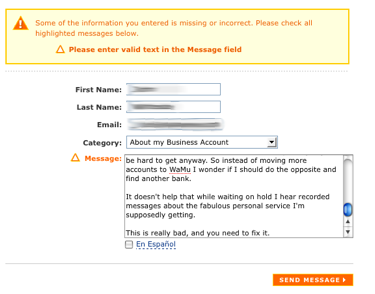This seems obvious, right? We've got all of this old technology (like phones), not so new technology (email, your web site), and cutting-edge stuff (social networks) available, and so we should use it to improve communications with our customers. Improvement means not just talking in more ways, but more useful ways. We can make it easier for customers to find the right people in the organization to help them. We can put useful information at their fingertips. We can help would-be customer evangelists spread the word.
Or, we could not bother. I experienced an example of this with Washington Mutual, the bank whose ads position them as the happy bank with a human face where you don't have to go through layers of bureaucracy to get help.
The other day I got an email from them about a business account, informing me that my phone number had been changed. The problem was, I hadn't changed any phone number with them, and the number now on my account was not mine. (It was a number of mine with one digit changed - weird.)
My first thought, of course, was that the security of my account might have been compromised. The email ended with a note that if I had not made this change, I should call an 800 number right away.
Which is precisely what I did. Did that 800 number take me to a security department that could figure out what was going on? Or at least to a person, because obviously this problem required human intervention?
Oh, no. "Welcome to Washington Mutual! Para informacion en espanol...."
I was at the top level of the main service menu. And a funny thing about WaMu's main menu: there is no option that sounds right for "I think my account security has been compromised." And there is no option to speak to a person. (Hitting "0" gives you a "bad customer, that wasn't a choice!" option.)
Is that really the experience you want a customer to have when they are sitting there wondering if someone's gotten into their account and is taking their money?
I eventually chose the option to find out about recent transactions, and then intentionally entered an incorrect access code, which bounced me from voicemail to a person, who had no idea how my phone number got changed (but did reset my password).
The very next day, I had an almost identical experience with them when I tried to activate a new ATM card on the web. I got an error message indicating that the information I entered didn't match what they had. So I went through the same "no menu option makes sense for what's happening" hassle, eventually got a person who activated my card (and verified that all the information I entered did indeed match what they had).
I am the customer who lets a company know when something is wrong, so I clicked the "contact us" link on their web site, and wrote a short message in the form provided to tell them that it's not okay with me that when there is a potentially serious problem, I'm shunted to a voicemail system offering me no useful options or a way to get a person easily. (How hard is it to set up a special 800 number?) And that these two experiences left me feeling very unsure whether any of their IT systems works properly and my money is safe with them.
I was pleased to find that form; far too many companies still have web sites designed to prevent customer feedback: no forms, no email addresses, or forms that are designed to let customers only submit structured information that the company wants to hear, rather than other feedback from customers who care enough to tell them what's going on. Okay, I thought, score one for WaMu.
And then I clicked send.

The form doesn't work. I tried in two different browsers in case I was having some browser-specific issue. You can't talk back to them.
This is such basic stuff. There are still a whole lot of companies out there who, before they try to tackle new media, or spend money on ads about how friendly and approachable they are, need to do the basics: create a web site that makes interaction with customers easier, not more frustrating for them.
No comments:
Post a Comment